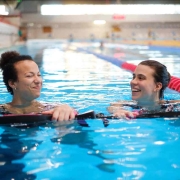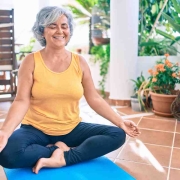Moving Forward with Back Pain
Has living with chronic low back pain affected your productivity, mobility, and overall ability to enjoy life?
In the United States, it’s estimated that nearly 16 million adults experience chronic back pain, making it one of the most costly health expenses annually and one of the most common complaints heard in doctors’ offices. Causes can include injury, disease (i.e. arthritis, cancer), obesity, poor posture, a sedentary lifestyle, even infection.
Patients with acute and sub-acute cases (pain that goes away within 3 months) may find that their pain improves over time without treatment of any kind. But not everyone has the ability to simply wait it out. In these cases, and when the pain becomes chronic, the American College of Physicians (ACP) recommends that non-invasive and non-drug therapies like exercise, acupuncture, massage, yoga, and other mind-body therapies should be the first line of treatment over surgery and narcotics, and we agree!
Remember, chronic pain, including low back pain, is a symptom of inflammation. Without targeting the root cause of the inflammation and treating it, your pain symptoms will not improve. Mind-body therapies help calm the inflammatory process in the body, promote healing, and present little to no risk to the patient.
Here are 3 common misconceptions about treating back pain that can contribute to a slower recovery.
Myth 1: Exercise makes back pain even worse
Putting the brakes on exercise may seem like a good idea when you’re feeling pain symptoms, but research shows that the opposite is true.
Strengthening and stretching exercises combined with aerobic activity will improve back pain symptoms by increasing blood flow, improving range of motion and flexibility, and strengthening core muscles.
· Physical Therapy is a great place to start if you’re concerned about further injuring or straining your back. Physical therapists have outstanding manual skills with a comprehensive understanding of body mechanics. They can work with you to decrease pain, improve movement, and provide instruction on how to continue moving safely in your everyday life.
· Going for a walk is one of the easiest ways to stay active. Try taking a short walk every day to keep your heart pumping and blood flowing.
· The poses, controlled breathing, and meditation involved in the practice of yoga can not only improve symptoms of chronic low back pain but can lower instances of depression and use of medication. As reducing back pain requires improving core strength, yoga is great for increasing core stability and strength while increasing awareness of other areas that may need stretching and strengthening.
Watch: Sun Salutations A & B with Dr. Lisa Lilienfield
Questions? Give Us a Call!
Myth 2: NSAIDs can’t hurt
Occasional use of NSAIDs can certainly be helpful if patients have seen little improvement with non-invasive treatments. But a big misconception about these OTC (over the counter) painkillers is that they’re completely safe and harmless. Regular use of NSAIDs can lead to problems with gut ulcers, liver damage, and kidney damage.
Ironically NSAIDs can even heighten one’s sensitivity to pain. People who take them more than once a week should discuss this with their physician.
Myth 3: Mind-body therapies are unscientific
Dismissing the benefits of mind-body therapies is, at the least, misguided. There is a mountain of evidence that supports the use of alternative therapies for pain management.
· Acupuncture: This 2000-year-old practice is thought to work by blocking pain messages to the brain with competing stimuli that cause an increase of endorphins, the body’s natural painkillers, and the secretion of neurotransmitters, which affect one’s perception of pain.
Supporting research:
- Effectiveness of Acupuncture for Nonspecific Chronic Low Back Pain: A Systematic Review and Meta-Analysis
- Short-term effect of acupuncture dry needle in treatment of chronic mechanical low back pain: a randomized controlled clinical trial
- Clinical efficacy of acupuncture therapy combined with core muscle exercises in treating patients with chronic nonspecific low back pain: a systematic review and meta-analysis of randomized controlled trials
- Systematic review and meta-analysis of effects of acupuncture on pain and function in non-specific low back pain
Read: Relieve Your Chronic Back Pain with Acupuncture
· Massage Therapy: A study published in the Annals of Internal Medicine concluded that people who were treated with massage therapy, whether relaxation massage or structural massage (deep tissue massage), for their chronic back pain, saw benefits that lasted at least 6 months.
Additional research:
· Meditation: A study reported in the Journal of Neuroscience showed that patients who had received only a little more than 60 minutes of meditation training were able to dramatically reduce their experience of pain. Patients experienced a reduction in “pain intensity” of about 40 percent and a reduction in “pain unpleasantness” of 57 percent. According to the lead author of the study, Fadel Zeidan, “Meditation produced a greater reduction in pain than even morphine or other pain-relieving drugs, which typically reduce pain ratings by about 25 percent.”
Additional research:
- Mindfulness Meditation-Based Pain Relief Employs Different Neural Mechanisms Than Placebo and Sham Mindfulness Meditation-Induced Analgesia
- Effects of mindfulness meditation on chronic pain: a randomized controlled trial
Bottom line
Whether you have an acute, sub-acute, or chronic case of low back pain, the first line of treatment should be a therapy that can help calm the body’s inflammatory process naturally and safely. While there is unquestionably a time and a place for surgery or narcotics, medical evidence indicates that conservative treatment of low-back pain is often as effective.
If low back pain is interfering with your quality of life, please give us a call to learn more about how we can help with these wonderful and science-based therapies that can benefit your mind, body, and soul.
We are here for you, and we want to help.
Our goal is to return you to optimal health as soon as possible. To schedule an appointment please call: 703-532-4892 x2









Leave a Reply
Want to join the discussion?Feel free to contribute!